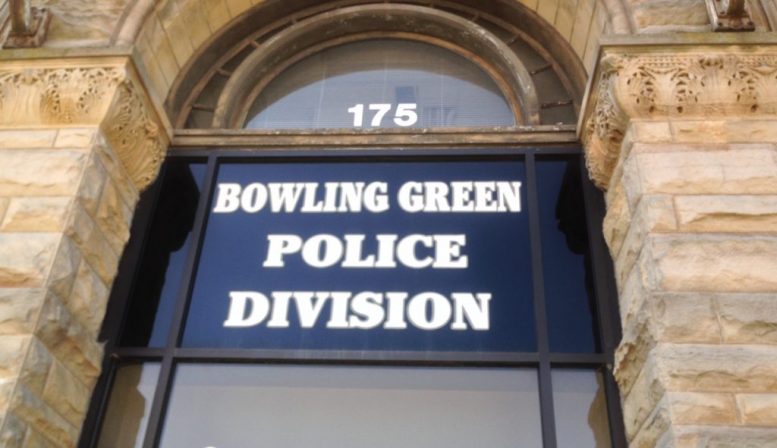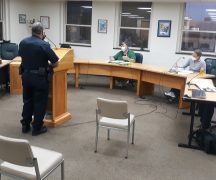By JAN LARSON McLAUGHLIN
BG Independent News
At a time when voices are raised about police use of force across the nation, Bowling Green Police Division gave its citizens a chance to sound off.
The Commission on Accreditation for Law Enforcement Agencies had to take public comments online this year due to COVID-19, but publicized the opportunity for people to speak up during a two-hour window last month.
The only comments were praise for BGPD doing a great job during a difficult time in the nation.
Retired Police Chief Brad Conner called the division “exceptional.” Bowling Green Police Division is a leader in the community, being involved in groups like the city’s Human Relations Commission, the East Side Neighborhood Group, and Not In Our Town, he said.
The police division works with community partners to respond to incidents of domestic violence, mental health problems, child abuse and neglect, and issues at BGSU.
“We don’t police the community. We police for the community,” Conner said.
Bowling Green Police Division is full of well-trained professional officers, who deserve to be appreciated by the community and re-accredited by CALEA, he said.
Another citizen to call in, Tim Stechschulte, also spoke highly of the BGPD.
“I think it’s a very professional organization,” he said, noting the number of accreditations earned by the police division.
Stechschulte voiced concerns about the division’s ability to operate at its highest level, and referred to the recent decision by the mayor to cancel de-escalation police training planned for this fall. The mayor stated the training was canceled due to COVID-19, but the firm doing the training has been criticized for promoting excessive use of force.
“It was squashed. I’m concerned about that,” Stechschulte said. BGPD is “hamstrung with one hand tied behind its back.”
“I just want to give the police my full support,” he said. “Everything going on in our country is a big concern.”
The public comment session was part of the CALEA re-accreditation process for the police division.
Lt. Dan Mancuso, who serves as BGPD’s accreditation manager, and the CALEA representative lamented the fact that the pandemic prevented the normal in-person visits by CALEA officials.
The CALEA assessor, Robert Van Nieuwenhuyze, said the Bowling Green Police Division review was going well.
“They seem to be a first rate department,” Nieuwenhuyze said.
Normally, CALEA officials spend time in the community, talking with citizens, public officials and police representatives. The four-year review process involves studying policies and incidents. Much of that process had to be done remotely this year. The police division will be notified in November if it qualifies for re-accreditation.
“They want to determine if we are meeting best practices,” Mancuso said.
“The agency believes it’s important,” he said. “We want to make sure we show the best practices for the profession.”
The accreditation process is voluntary, with just 5-10 percent of law enforcement agencies opting to seek CALEA accreditation. CALEA, which is considered the “gold standard” of law enforcement credentialing, has 484 standards that must be met annually.
Bowling Green was originally accredited in 1993. The department has been reaccredited at three-year intervals since then. This is the eighth time the department has gone through the process.
As part of the annual reaccreditation process, the police division has to make public its statistics on issues such as use of force and bias-based policing.
Complaints about excessive force, which can be made anonymously, go through several levels of investigation, including the officer’s sergeant, internal affairs, Chief Tony Hetrick, the municipal administrator, and the mayor.
Eight complaints were filed last year. Details on all those complaints are not yet available, since CALEA is behind on its annual reports due to the coronavirus pandemic.
BGPD’s code of conduct requires officers to do more than stand by when excessive force is being used, and requires officers to report any excessive use of force.
Anytime force is used – whether it’s a Taser, baton, pepper spray, or firearm – it must be reported. Any weaponless force, such as when an officer displaces a person’s balance through pushing or using pressure holds, must also be reported.
BGPD officers used force 21 times last year. In the vast majority of cases, the police did not use weapons. The last officer involved shooting in Bowling Green was in 2011.
Mancuso said BGPD officers are trained and tested to not use excessive force.
One way Bowling Green officers are trained to de-escalate a scene is by other officers getting involved once a suspect is in custody. For example, if someone resists being taken into custody, once another officer arrives on the scene, the secondary officer takes control of the arrested person, Mancuso said.
When a supervisor arrives on the scene, that officer takes control – separating the suspect from the arresting officers..
Bowling Green police are also trained to not stand by if a fellow officer is using excessive force, Mancuso said.
“We would expect them to intervene and take control,” he said. “We’re not going to allow our officers to stand by. They are just as culpable” if they don’t intervene.
Though police train with firearms, Tasers, pepper spray and batons, they are taught to use their minds and words first whenever possible.
Officers’ records are reviewed quarterly to look for any bias in policing tactics. The police division conducts trainings to make sure profiling isn’t used in areas such as traffic stops, search issues, asset seizure and forfeiture, and interview techniques. Annual training is required in cultural diversity, discrimination and community support.
Following are the “8 Can’t Wait” policies used by BGPD that reportedly can decrease police violence by 72%:
Chokeholds/Strangleholds – The BG Police Division does not authorize the use of neck restraints except in defense of human life. Bottom line, an officer would only use this as a technique of opportunity in a deadly force situation, Deputy Chief Justin White said.
Require De-escalation – Crisis Intervention Training (CIT) and de-escalation has been an on-going division training priority since 2003. The police division works closely with Wood County ADAMHS Board, NAMI, and local mental health providers. CIT and de-escalation is more than just a concept, it is ingrained in the culture of the division, White said. Officers utilize these techniques on a regular basis, which has resulted in a reduction of officers using force.
Require Warning before Shooting – Policy does not require a warning prior to shooting; however, officers are instructed to provide a warning, if feasible.
Exhaust All Means before Shooting – The division’s policies and training covers various options to de-escalate a situation, if possible, and to only use the amount of force necessary to control and/or neutralize the situation.
Duty to Intervene – Officers are required to intervene if unnecessary force is used, and report such incidents.
Ban Shooting from Moving Vehicles – The division does not allow shooting from vehicles.
Require Use of Force Continuum – Several of the division’s use of force policies address Action-Response Use of Force Continuum, which is covered extensively in trainings.
Require Comprehensive Reporting – All officers must complete a Response to Resistance/Aggression (RRA) report as soon as practical following the incident. Officers will complete reports in all instances of injury, observation of injury, complaint of excessive force, and/or force used above the level of balance displacement.





